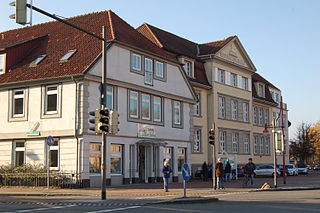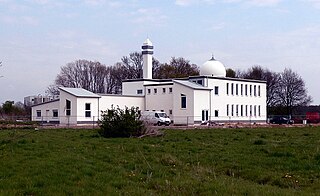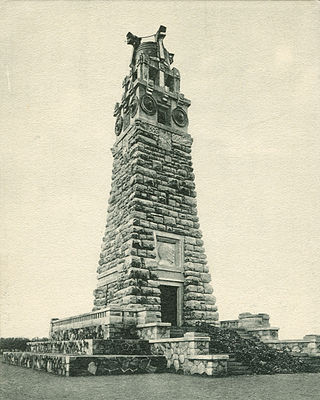
The Colossus of Ostermunzel is a 27.5-tonne glacial erratic stone found in a farmer's field east of Ostermunzel in Lower Saxony, Germany, in 2013. [1] [2] It was excavated and moved to a new location a kilometre away.

The Colossus of Ostermunzel is a 27.5-tonne glacial erratic stone found in a farmer's field east of Ostermunzel in Lower Saxony, Germany, in 2013. [1] [2] It was excavated and moved to a new location a kilometre away.
This glacial erratic, a piece of rock that differs from the size and type of rock native to the area in which it rests, was found by a farmer who was ploughing his land in 2013. [3] The field in which it was discovered lies on a small hill near the district road K 253 between Ostermunzel and Dedensen. Upon discovering it, the owner of the field informed local authorities in accordance with the Lower Saxon natural protection law that discoveries of rocks that are more than 2 metres across (6½ ft) must be reported. The Hanover Region objected to its planned demolition. [4]

A preliminary investigation and assessment by Heinz-Gerd Röhling of the State Office of Mining, Energy and Geology ( Landesamt für Bergbau, Energie und Geologie ) found that the stone qualified as a natural monument. [5] Its large size is abnormal, particularly for northern Germany and especially for Lower Saxony. [6] Due to the estimated €20,000 cost of its removal, the Hanover Region, which was in charge of what to do with the stone, initially decided to leave it where it was discovered. However, after reconsideration, the stone was removed intact in the spring of 2015 by a mobile crane and transported by a low loader to the Mühlenberg hill approximately 1 kilometre (0.6 miles) away for exhibition. Around 400 bystanders witnessed the excavation and transport. The removal costs totaled €15,000, with the expense borne by the Hanover Region. [7] The new site is at a picnic area close to a bicycle path. [8]
The glacial erratic stone's approximate measurements are 2.6 metres (8½ ft) high by 3.2 metres (10½ ft) wide, with a circumference of 10 metres (33 ft). Its weight was originally estimated to be 50 tonnes, [9] but was found to be 27.5 tonnes when it was weighed at the time of its removal from the field where it was found and excavated. [2]
Geologists inspected the stone. It is probably composed of gneiss, estimated to be 1.4 to 1.6 billion years old. [7] The mineral composition was preliminarily observed to be feldspar and biotite. It was brought to the region by a glacier from Scandinavia, probably from Sweden. [8]

Sprengel Museum is a museum of modern art in Hanover, Lower Saxony, holding one of the most significant collections of modern art in Germany. It is located in a building situated adjacent to the Masch Lake approximately 150 metres (490 ft) south of the state museum. The museum opened in 1979, and the building, designed by Peter and Ursula Trint and Dieter Quast, was extended in 1992.

The Telemax is a telecommunications tower built from 1988 to 1992 in Hanover. It was designed by Hans U. Böckler and is 272 metres (892 ft) high. The tower stands on a 10-metre-high (33 ft) base building, which brings its overall height to 282 metres (925 ft). The tower is the fifth-tallest telecommunications tower in Germany. The owner and operator of the site is Deutsche Funkturm, a subsidiary of Deutsche Telekom.

Barsinghausen is a town in the district of Hanover, in Lower Saxony, Germany. It is situated at the Deister chain of hills approx. 20 km west of Hanover. Barsinghausen belongs to the historic landscape Calenberg Land and was first mentioned in 1193.

Ernst August, Hereditary Prince of Hanover is the eldest child of Ernst August, Prince of Hanover, and his first wife Chantal Hochuli. Due to his father's second marriage, he is also the stepson of Caroline, Princess of Hanover, a Monegasque Princess and the sister of Albert II of Monaco.

The New Town Hall is a town hall in Hanover, Germany. It opened on 20 June 1913 after construction lasting 12 years. A magnificent, castle-like building of the era of Wilhelm II in eclectic style at the southern edge of the inner city just outside the historic city centre of Hanover, the building is embedded within the 10-hectare (25-acre) Maschpark.

The Cellesche Zeitung is a medium-size local newspaper with a circulation of 32,200. It is distributed in the town and district of Celle in North Germany by Schweiger & Pick Verlag. Apart from the periphery of its area with Hanover Region, where it also competes with the Hannoversche Allgemeine Zeitung, the Cellesche Zeitung has a monopoly over local reporting.

The Baitus Sami mosque is located in the German city of Hanover. It has both a dome and minaret, although the minaret is too slender to be climbed. Built by an Ahmadiyya community, the mosque comprises approximately 2,800 square metres (30,000 sq ft), with space for 300 worshippers. Situated at a street in an industrial area outside a nearby residential area, it was inaugurated in August 2008 by the Caliph of the community, Mirza Masroor Ahmad. The construction of the mosque was opposed by many local people, with sometimes violent protests.

Hans Joachim Schliep is a German Lutheran theologian, pastor and author. From 1990 to 1999 he was director of the Amt für Gemeindedienst, and by May 2000 the commissioner for the environment of the Church of Hanover and the Confederation of Protestant Churches in Lower Saxony. From 1999 to 2008 Schliep was the first pastor at the Kronsberg Church Centre and founder of the congregation at the Expo-neighbourhood in Kronsberg, Hanover, Lower Saxony, Germany.

Hanover University of Music, Drama and Media is a university of performing arts and media in Hanover, the capital of Lower Saxony, Germany. Dating to 1897, it has reorganised and changed names as it developed over the years, most recently in 2010 when it changed from State College of Music and Drama Hanover. From 2010 until March 2024, its president was Susanne Rode-Breymann. As of 2023, the university has 1,447 students, and as of 2021 a total of 477 staff.
The NDR Radiophilharmonie is a German radio orchestra, affiliated with the Norddeutscher Rundfunk (NDR) in Hanover, the capital of Lower Saxony. The orchestra principally gives concerts in the Großer Sendesaal of the Landesfunkhaus Niedersachsen.

The Bismarck Tower in Hanover, Germany was a tower erected as a monument to the first Chancellor of the united German nation Otto von Bismarck for patriotic and nationalistic purposes, which then became a hub for national socialist events in the city until its dismantlement in 1935 as part of the building of the Maschsee.

Erhard Egidi was a German cantor, organist and composer of sacred music. He was Kantor at the Neustädter Kirche, Hannover, from 1972 to 1991, where he focused on music in church services, but also conducted concerts, with a preference for works of Johann Sebastian Bach and his own teacher Ernst Pepping. He was appointed Kirchenmusikdirektor, responsible for the church music of Hanover.

Stefan Schostok is a German politician of the Social Democratic Party and was Mayor of Hanover from 11 October 2013 until 26 May 2019. From 2008 to January 2013 he served as a member of the Lower Saxony Legislative Assembly. During that time, he was elected chairman of the SPD group in the Lower Saxony Legislative Assembly (Landtag) in 2010, a position which he vacated in 2013.

Aegidien Gate Square is a busy square known colloquially as Aegi in Hanover, Germany. Located above a subway station of the same name, the square was named for the Aegidien Gate, one of the city gates of medieval Hanover. While the gate was removed in 1780, the square is still named after it.
Heinrich Sievers was a German musicologist, music critic, university lecturer, and conductor. He was regarded as an authority on the history of music in Hanover and Lower Saxony, and wrote music-historical monographs in English and Finnish publications.

Klaus Mlynek is a German historian and scientific archivist, a former director of the City of Hanover Archive, and one of the editors and authors of the Hannover City Lexicon, an encyclopedia of Hanover.

Hanover Historical Museum is an historical museum situated in Hanover, the capital of Lower Saxony, Germany. The museum was founded in 1903 as the Homeland Museum of the City of Hanover. Its collections are related to the history of the city, the history of the House of Guelf, and of the state of Lower Saxony.
Frank Armin Hanebuth is a German outlaw biker, professional boxer and alleged gangster. Hanebuth has been described in the media as the boss of all the Hells Angels in Europe.

Rolf Zick was a German journalist.
The Enercity Aktiengesellschaft in Hanover is a municipal energy supply and energy services company. Its revenue was €9.2 billion in 2023, and it employed more than 3,300 people across the group. In 2018, the brand name enercity became the official company name when Stadtwerke Hannover Aktiengesellschaft was renamed to enercity Aktiengesellschaft. The owners are Versorgungs- und Verkehrsgesellschaft Hannover (76%) and Thüga AG (24%).